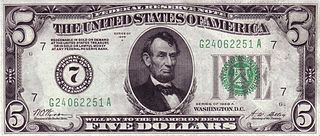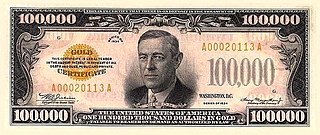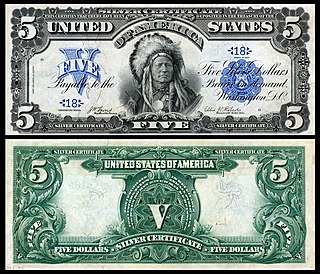
Federal Reserve Notes are the currently issued banknotes of the United States dollar. The United States Bureau of Engraving and Printing produces the notes under the authority of the Federal Reserve Act of 1913 and issues them to the Federal Reserve Banks at the discretion of the Board of Governors of the Federal Reserve System. The Reserve Banks then circulate the notes to their member banks, at which point they become liabilities of the Reserve Banks and obligations of the United States.

The Bureau of Engraving and Printing (BEP) is a government agency within the United States Department of the Treasury that designs and produces a variety of security products for the United States government, most notable of which is Federal Reserve Notes for the Federal Reserve, the nation's central bank. In addition to paper currency, the BEP produces Treasury securities; military commissions and award certificates; invitations and admission cards; and many different types of identification cards, forms, and other special security documents for a variety of government agencies. The BEP's role as printer of paper currency makes it one of two Treasury Department agencies involved in currency production. The other is the United States Mint, which mints coinage. With production facilities in Washington, D.C., and Fort Worth, Texas, the Bureau of Engraving and Printing is the largest producer of government security documents in the United States.

The United States five-dollar bill (US$5) is a denomination of United States currency. The current $5 bill features U.S. president Abraham Lincoln and the Great Seal of the United States on the front and the Lincoln Memorial on the back. All $5 bills issued today are Federal Reserve Notes. As of December 2018, the average life of a $5 bill in circulation is 4.7 years before it is replaced due to wear. Approximately 6% of all paper currency produced by the U.S. Treasury's Bureau of Engraving and Printing in 2009 were $5 bills.

The United States ten-dollar bill (US$10) is a denomination of U.S. currency. The obverse of the bill features the portrait of Alexander Hamilton, who served as the first U.S. Secretary of the Treasury, two renditions of the torch of the Statue of Liberty, and the words "We the People" from the original engrossed preamble of the United States Constitution. The reverse features the U.S. Treasury Building. All $10 bills issued today are Federal Reserve Notes.

The United States twenty-dollar bill (US$20) is a denomination of U.S. currency. A portrait of Andrew Jackson, the seventh U.S. president (1829–1837), has been featured on the obverse of the bill since 1928; the White House is featured on the reverse.

The United States fifty-dollar bill (US$50) is a denomination of United States currency. The 18th U.S. president (1869-1877), Ulysses S. Grant, is featured on the obverse, while the U.S. Capitol is featured on the reverse. All current-issue $50 bills are Federal Reserve Notes.

The United States one-hundred-dollar bill (US$100) is a denomination of United States currency. The first United States Note with this value was issued in 1862 and the Federal Reserve Note version was first produced in 1914. Inventor and U.S. Founding Father Benjamin Franklin has been featured on the obverse of the bill since 1914, which now also contains stylized images of the Declaration of Independence, a quill pen, the Syng inkwell, and the Liberty Bell. The reverse depicts Independence Hall in Philadelphia, which it has featured since 1928.

The United States one-dollar bill (US$1), sometimes referred to as a single, has been the lowest value denomination of United States paper currency since the discontinuation of U.S. fractional currency notes in 1876. An image of the first U.S. president (1789–1797), George Washington, based on the Athenaeum Portrait, a 1796 painting by Gilbert Stuart, is currently featured on the obverse, and the Great Seal of the United States is featured on the reverse. The one-dollar bill has the oldest overall design of all U.S. currency currently being produced. The reverse design of the present dollar debuted in 1935, and the obverse in 1963 when it was first issued as a Federal Reserve Note.

Silver certificates are a type of representative money issued between 1878 and 1964 in the United States as part of its circulation of paper currency. They were produced in response to silver agitation by citizens who were angered by the Fourth Coinage Act, which had effectively placed the United States on a gold standard. The certificates were initially redeemable for their face value of silver dollar coins and later in raw silver bullion. Since 1968 they have been redeemable only in Federal Reserve Notes and are thus obsolete, but still valid legal tender at their face value and thus are still an accepted form of currency.

The Series of 1928 was the first issue of small-size currency printed and released by the U.S. government. These notes, first released to the public on July 10, 1929, were the first standardized notes in terms of design and characteristics, featuring similar portraits and other facets. These notes were also the first to measure 6.14" by 2.61", smaller than the large-sized predecessors of Series 1923 and earlier that measured 7.375" by 3.125".
This page is a glossary of notaphily. Notaphily is the study of paper money or banknotes.
In early 18th century Colonial America, engravers began experimenting with copper plates as an alternative medium to wood. Applied to the production of paper currency, copper-plate engraving allowed for greater detail and production during printing. It was the transition to steel engraving that enabled banknote design and printing to rapidly advance in the United States during the 19th century.
A silver certificate is a certificate of ownership that silver owners hold instead of storing the actual silver. Several countries have issued silver certificates, including Cuba, the Netherlands, and the United States. Silver certificates have also been privately issued by various mints and bullion companies. One example was the Liberty Dollar issued by NORFED from 1998 to 2009.

The United States two-dollar bill (US$2) is a current denomination of United States currency. A portrait of Thomas Jefferson, the third president of the United States (1801–1809), is featured on the obverse of the note. The reverse features an engraving of John Trumbull's painting Declaration of Independence.

The United States one-hundred-thousand-dollar bill (US$100,000) is a former denomination of United States currency issued from 1934 to 1935. The bill, which features President Woodrow Wilson, was created as a large denomination note for gold transactions between Federal Reserve Banks; it never circulated publicly and its private possession is illegal.

The Black Eagle is a type of one-dollar silver certificate produced in 1899 in the United States. The note measured 7.38 in (187 mm) by 3.18 in (81 mm); it was of the large-size variety of bank-notes issued by the United States. The note featured a Bald eagle with its wings spread. The note was also referred to as "Eagle of the Capitol", because the United States Capitol is visible behind the eagle. The note was issued from 1899 to 1923 and the Bureau of Engraving and Printing (BEP) printed 3,604,239,600 Black Eagles. Because of the large size, it is colloquially referred to as a "horseblanket".

The United States 1000 dollar bill(US$1000) is an obsolete denomination of United States currency. It was issued by the US Bureau of Engraving and Printing (BEP) beginning on 1861 and ending in 1934. The bill was recalled in 1969 but it is still legal tender.

The United States 10,000-dollar bill(US$10000) (1878–1934) is an obsolete denomination of the United States dollar. The $10,000 note was the highest denomination of US currency to be used by the public and was no longer issued after 1969. These notes are still legal tender, and thus banks will redeem them for face value. However, their value to collectors is well above their face value.

History Instructing Youth is a series 1896 United States one-dollar bill. It was one of three notes in the US Bureau of Engraving and Printing's (BEP) Educational Series. After many complaints about the notes in the series, the BEP replaced them in 1899. Today, it is considered one of the most beautiful and popular US large-size notes. The scene on the note's obverse is allegorical and features a woman who is instructing a young boy about United States history.

The 1899 United States five-dollar Silver Certificate is known as the Indian Chief Note note. The note features Sioux chief Running Antelope wearing an incorrect war bonnet. It is the only US federal paper currency featuring a named Native American.

















